Influence of TiN Inclusions and Segregation on the Delayed Cracking in NM450 Wear-Resistant Steel
Abstract
:1. Introduction
2. Materials and Methods
3. Results and Discussion
3.1. Crack Analysis
3.2. Tensile Properties
3.3. Fractography
3.3.1. Fracture Surface
3.3.2. Transverse Section of the Tensile Fracture Surface
3.4. Microstructure
3.4.1. Distribution of TiN Inclusions
3.4.2. Dislocation Density Analysis
3.4.3. EBSD Analysis
4. Conclusions
- Delayed cracking appeared up to a few days after the flame cutting of the NM450 steel plate. Cracks were found to originate from an SZ that contained multiple high-hardness segregation bands.
- The tensile strength of the NM450 steel in the SZ was higher than that in the NSZ, but the total elongation and reduction of area in the SZ were relatively low. The tensile fracture surface of the specimens was characterized by ductile dimples, tear ridges, a few quasi-cleavage surfaces and secondary cracks. A higher percentage of quasi-cleavage and secondary cracks were found in the fracture surface of the SZ specimen compared to the NSZ specimen.
- Regular-shaped TiN inclusions with high hardness and poor deformability were more harmful than circular and deformable CaO·(Al2O3)x inclusions. The latter was observed to cause a deep ductile dimple, while the former initiated a brittle quasi-cleavage fracture. The size and number of TiN inclusions in the SZ were relatively greater than those in the NSZ, which induced more quasi-cleavage fractures. This was also why the total fracture elongation and reduction of area in SZ were less than those in the NSZ. The dislocation density in the SZ was higher than that in the NSZ, increasing the hardness and strength of the SZ, which initiated the delayed cracking.
Author Contributions
Funding
Institutional Review Board Statement
Informed Consent Statement
Data Availability Statement
Acknowledgments
Conflicts of Interest
References
- Nikitin, V.N.; Nastich, S.Y.; Smirnov, L.A.; Mal’tsev, A.B.; Denisov, S.V.; Chevskaya, O.N.; Brylin, A.M.; Kurash, V.S.; Maslyuk, V.M.; Tarasov, V.M. Economically alloyed high-strength steel for use in mine equipment. Steel Trans. 2016, 46, 742–751. [Google Scholar] [CrossRef]
- Bae, K.Y.; Yang, Y.S.; Yi, M.S.; Park, C.W. Numerical analysis of heat flow in oxy-ethylene flame cutting of steel plate. Proc. Inst. Mech. Eng. Part. B-J. Eng. Manuf. 2018, 232, 742–751. [Google Scholar] [CrossRef]
- Chida, T.; Haihara, Y.; Akiyama, E.; Iwanaga, K.; Takagi, S.; Hayakawa, M.; Ohishi, H.; Hirakami, D.; Tarui, T. Comparison of constant load, SSRT and CSRT methods for hydrogen embrittlement evaluation using round bar specimens of high strength steels. ISIJ Int. 2016, 56, 1268–1275. [Google Scholar] [CrossRef] [Green Version]
- Hirakami, D.; Yamasaki, S.; Tarui, T.; Ushioda, K. Competitive phenomenon of hydrogen trapping and carbon segregation in dislocations introduced by drawing or martensitic transformation of 0.35 mass% and 0.8 mass% C steels. ISIJ Int. 2016, 56, 359–365. [Google Scholar] [CrossRef] [Green Version]
- Kim, J.S.; Lee, Y.H.; Lee, D.L.; Park, K.T.; Lee, C.S. Microstructural influences on hydrogen delayed fracture of high strength steels. Mater. Sci. Eng. A 2009, 505, 105–110. [Google Scholar] [CrossRef]
- Geng, W.T.; Wang, V.; Li, J.X.; Ishikawa, N.; Kimizuka, H.; Tsuzaki, K.; Ogata, S. Hydrogen trapping in carbon supersaturated α iron and its decohesion effect in martensitic steel. Scr. Mater. 2018, 149, 79–83. [Google Scholar] [CrossRef]
- Cai, M.H.; Chen, L.G.; Fang, K.; Huang, H.S.; Hodgson, P. The effects of a ferritic or martensitic matrix on the tensile behavior of a nano-precipitation strengthened ultra-low carbon Ti–Mo–Nb steel. Mater. Sci. Eng. A 2021, 801, 140410. [Google Scholar] [CrossRef]
- Tian, Q.R.; Wang, G.C.; Zhao, Y.; Li, J.; Wang, Q. Precipitation behaviors of TiN inclusion in GCr15 bearing steel billet. Metall. Mater. Trans. B 2018, 49, 1149–1164. [Google Scholar] [CrossRef]
- Wu, X.; Zuo, X.R.; Zhao, W.W.; Wang, Z.Y. Mechanism of TiN fracture during the tensile process of NM500 wear-resistant steel. Acta Metall. Sin. 2020, 56, 129–136. [Google Scholar]
- Wang, Z.Y.; Wu, X.; Liu, D.H.; Zuo, X.R. Correlation between microstructure and fracture behavior in thick HARDOX 450 wear-resistant steel with TiN inclusions. Front. Mater. 2021, 8, 691551. [Google Scholar] [CrossRef]
- Laureys, A.; Claeys, L.; De Seranno, T.; Depover, T.; Van den Eeckhout, E.; Petrov, R.; Verbeken, K. The role of titanium and vanadium based precipitates on hydrogen induced degradation of ferritic materials. Mater. Charact. 2018, 144, 22–34. [Google Scholar] [CrossRef] [Green Version]
- Depover, T.; Laureys, A.; Escobar, D.P.; Van den Eeckhout, E.; Wallaert, E.; Verbeken, K. Understanding the interaction between a steel microstructure and hydrogen. Materials 2018, 11, 698. [Google Scholar] [CrossRef] [PubMed] [Green Version]
- Rajiah, S.; Sambandam, M.; Shanmugam, S.P.; Vikraman, S.; Taticherla, R. Inter-columnar macro-segregation in continuously cast steel; characterization, possible reasons, and consequence. Trans. Indian Inst. Met. 2021, 74, 1557–1568. [Google Scholar] [CrossRef]
- Costa e Silva, A. Using computational thermodynamics to understand the evolution of solidification segregation during steel processing. J. Phase Equilib. Diffus. 2020, 41, 522–531. [Google Scholar] [CrossRef]
- Laureys, A.; Depover, T.; Petrov, R.; Verbeken, K. Microstructural characterization of hydrogen induced cracking in TRIP-assisted steel by EBSD. Mater. Charact. 2016, 112, 169–179. [Google Scholar] [CrossRef]
- Tirumalasetty, G.K.; Van Huis, M.A.; Fang, C.M.; Xu, Q.; Tichelaar, F.D.; Hanlon, D.N.; Sietsma, J.; Zandbergen, H.W. Characterization of NbC and (Nb, Ti)N nanoprecipitates in TRIP assisted multiphase steels. Acta Mater. 2011, 59, 7406–7415. [Google Scholar] [CrossRef] [Green Version]
- Yang, G.W.; Wang, X.H. Inclusion evolution after calcium addition in low carbon Al-killed steel with ultra low sulfur content. ISIJ Int. 2015, 55, 126–133. [Google Scholar] [CrossRef] [Green Version]
- Liu, C.Y.; Jia, Y.; Hao, L.X.; Han, S.W.; Huang, F.X.; Yu, H.X.; Gao, X.; Ueda, S.; Kitamura, S.Y. Effects of slag composition and impurities of alloys on the inclusion transformation during industrial ladle furnace refining. Metals 2021, 11, 763. [Google Scholar] [CrossRef]
- Mizobe, K.; Honda, T.; Koike, H.; Santos, E.C.; Shibukawa, T.; Kida, K. Relationship between repeatedly quenching and fisheye cracks around TiN and Al2O3 inclusions in high carbon bearing steel. Mater. Res. Innov. 2014, 18, S160–S165. [Google Scholar] [CrossRef]
- Zhu, Y.; Lu, Y.M.; Huang, C.W.; Liang, Y.L. The effect of TiN inclusions on the fracture mechanism of 20CrMnTi steel with lath martensite. Mater. Res. Express. 2020, 7, 036509. [Google Scholar] [CrossRef]
- Liu, T.; Long, M.J.; Chen, D.F.; Duan, H.M.; Gui, L.T.; Yu, S.; Cao, J.S.; Chen, H.B.; Fan, H.L. Effect of coarse TiN inclusions and microstructure on impact toughness fluctuation in Ti micro-alloyed steel. J. Iron Steel Res. Int. 2018, 25, 1043–1053. [Google Scholar] [CrossRef]
- Li, Z.T.; Chai, F.; Yang, C.F.; Yang, L. Co-precipitation mechanism of nanoscale particles and mechanical properties in multicomponent ultra-high strength low carbon steel. Mater. Sci. Eng. A 2019, 748, 128–136. [Google Scholar] [CrossRef]
- HajyAkbary, F.; Sietsma, J.; Böttger, A.J.; Santofimia, M.J. An improved X-ray diffraction analysis method to characterize dislocation density in lath martensitic structures. Mater. Sci. Eng. A 2015, 639, 208–218. [Google Scholar] [CrossRef]
- Huang, M.; Rivera-Díaz-del-Castillo, P.E.J.; Bouaziz, O.; Van Der Zwaag, S. Modelling strength and ductility of ultrafine grained BCC and FCC alloys using irreversible thermodynamics. Mater. Sci. Technol. 2009, 25, 833–839. [Google Scholar] [CrossRef]
- Wu, D.; Wang, F.M.; Cheng, J.; Li, C.R. Effect of Nb and V on the continuous cooling transformation of undercooled austenite in Cr–Mo–V steel for brake discs. Int. J. Miner. Metall. Mater. 2018, 25, 892–901. [Google Scholar] [CrossRef]
- Macchi, J.; Gaudez, S.; Geandier, G.; Teixeira, J.; Denis, S.; Bonnet, F.; Allain, S.Y.P. Dislocation densities in a low-carbon steel during martensite transformation determined by in situ high energy X-Ray diffraction. Mater. Sci. Eng. A 2021, 800, 140249. [Google Scholar] [CrossRef]
- Zhou, T.; Yu, H.; Wang, S.Y. Effect of microstructural types on toughness and microstructural optimization of ultra-heavy steel plate: EBSD analysis and microscopic fracture mechanism. Mater. Sci. Eng. A 2016, 658, 150–158. [Google Scholar] [CrossRef]
- Liu, Q.; Fang, L.M.; Xiong, Z.W.; Yang, J.; Tan, Y.; Liu, Y.; Zhang, Y.J.; Tan, Q.; Hao, C.C.; Cao, L.H.; et al. The response of dislocations, low angle grain boundaries and high angle grain boundaries at high strain rates. Mater. Sci. Eng. A 2021, 822, 141704. [Google Scholar] [CrossRef]
- Chen, Y.; Liu, J.; Huang, F.; Chen, L.; Su, Y.J.; Zhou, G.F. Influence of inclusions on hydrogen-induced delayed cracking in hot stamping steels. J. Iron steel Res. Int. 2019, 26, 1199–1208. [Google Scholar] [CrossRef]
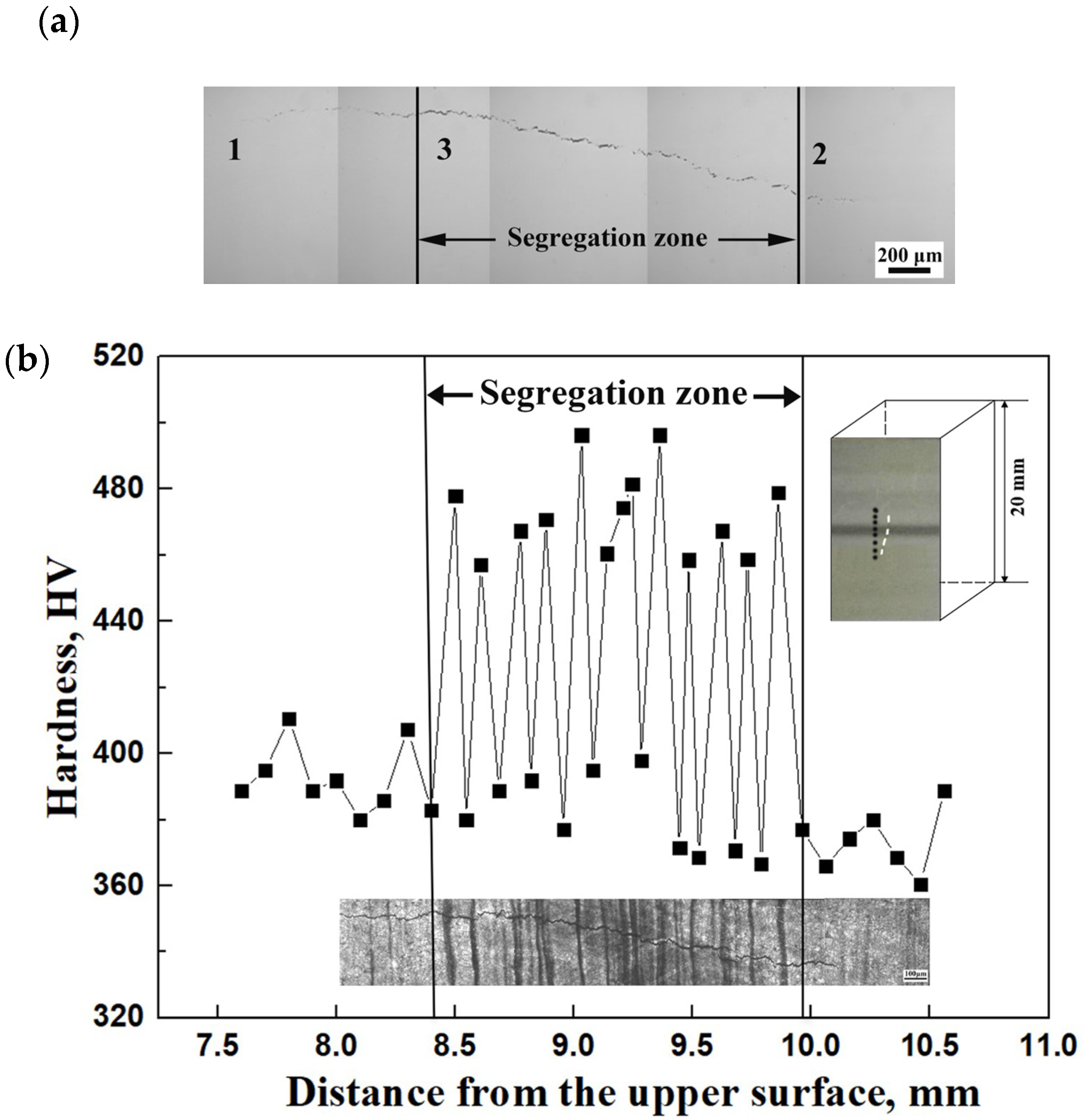
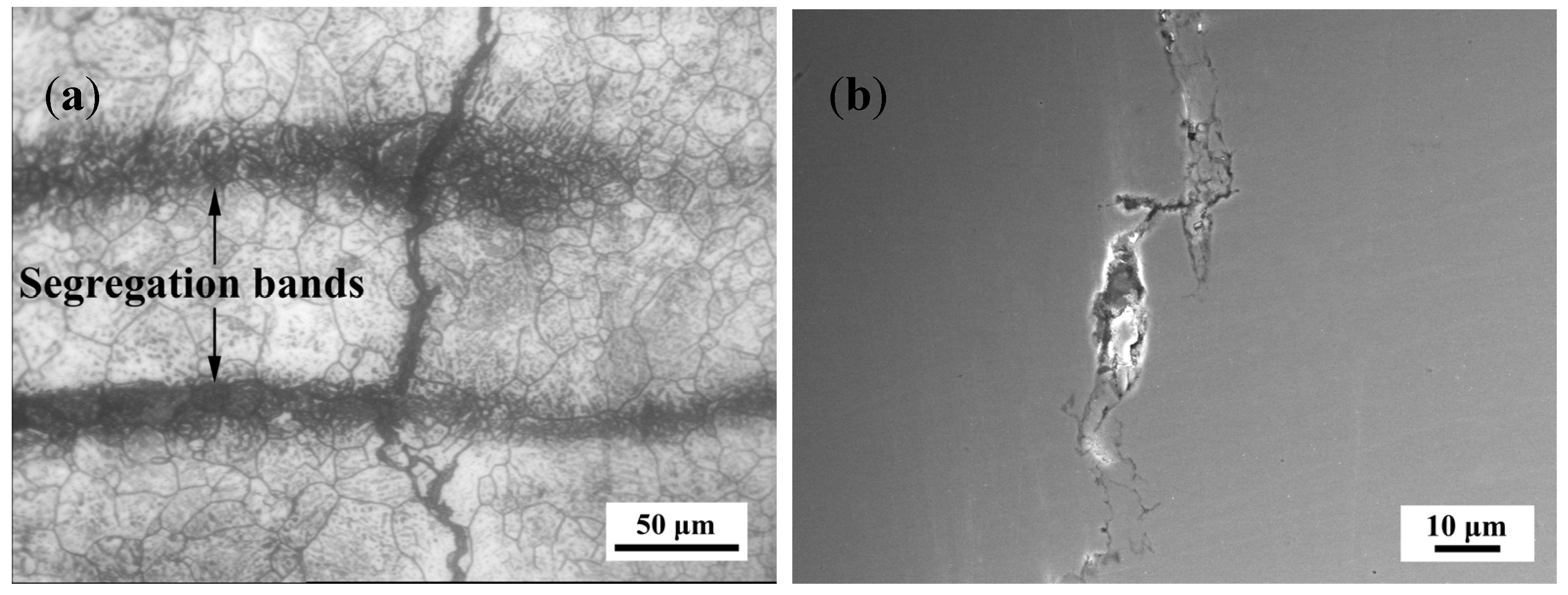
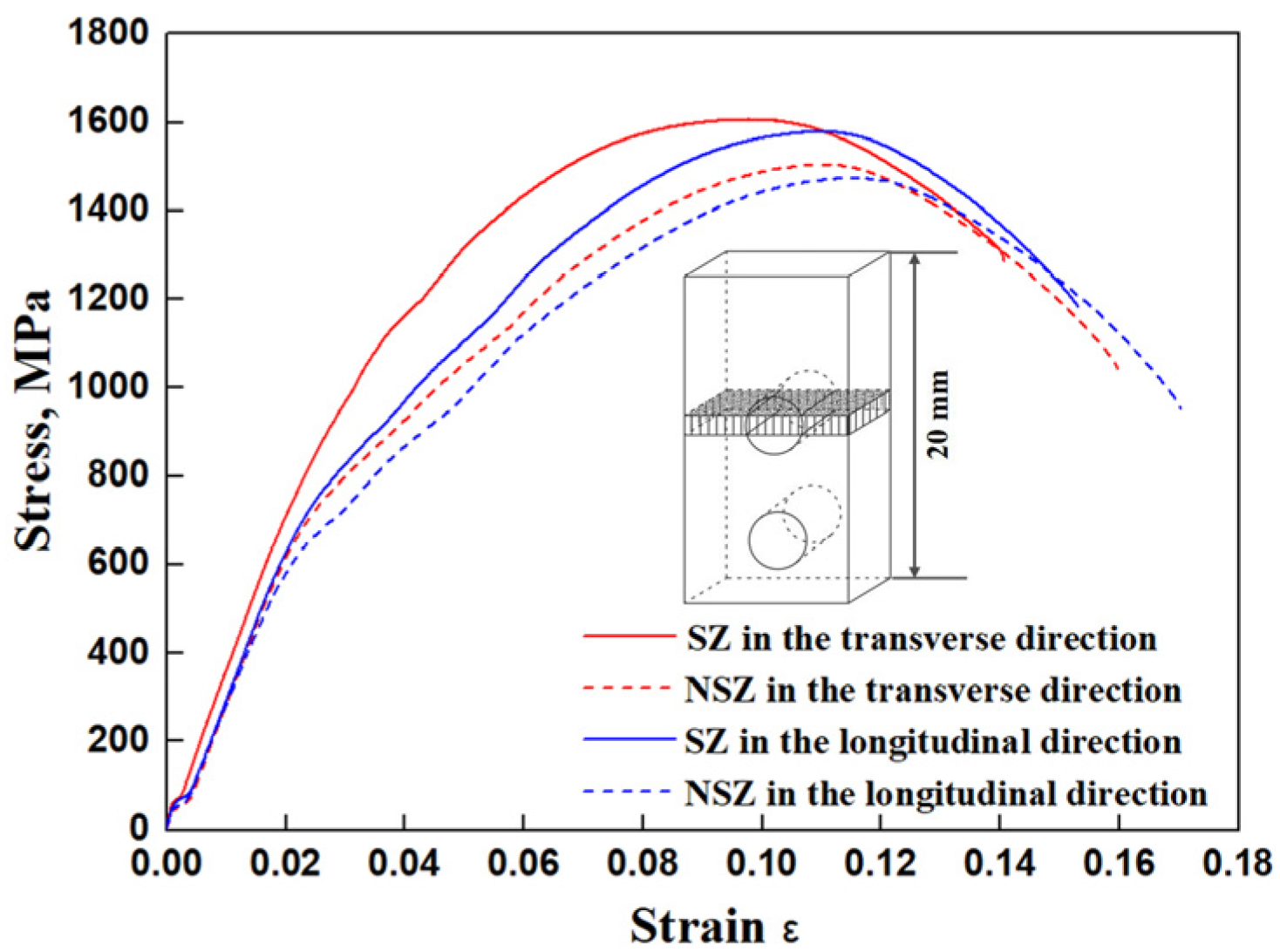
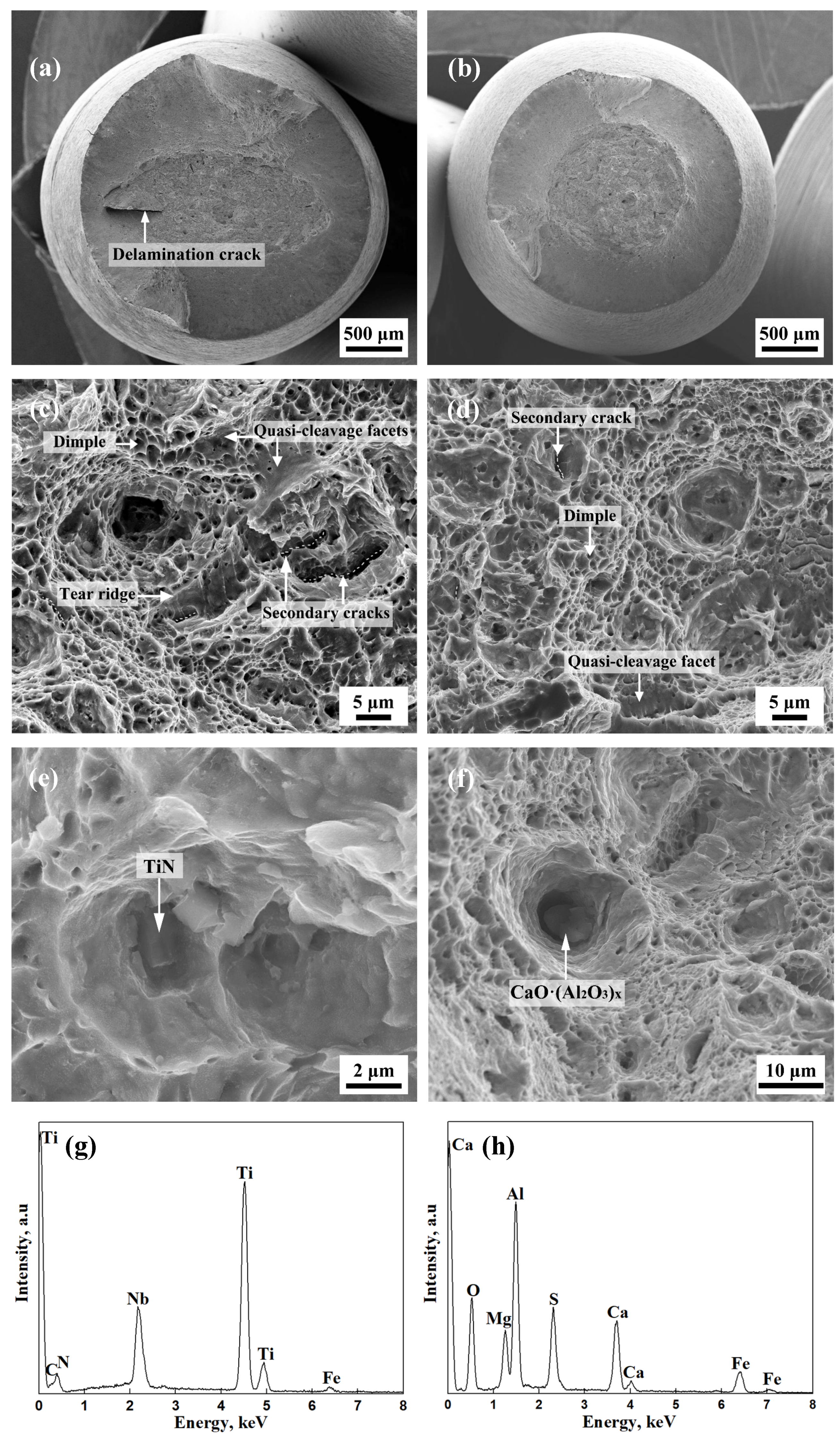
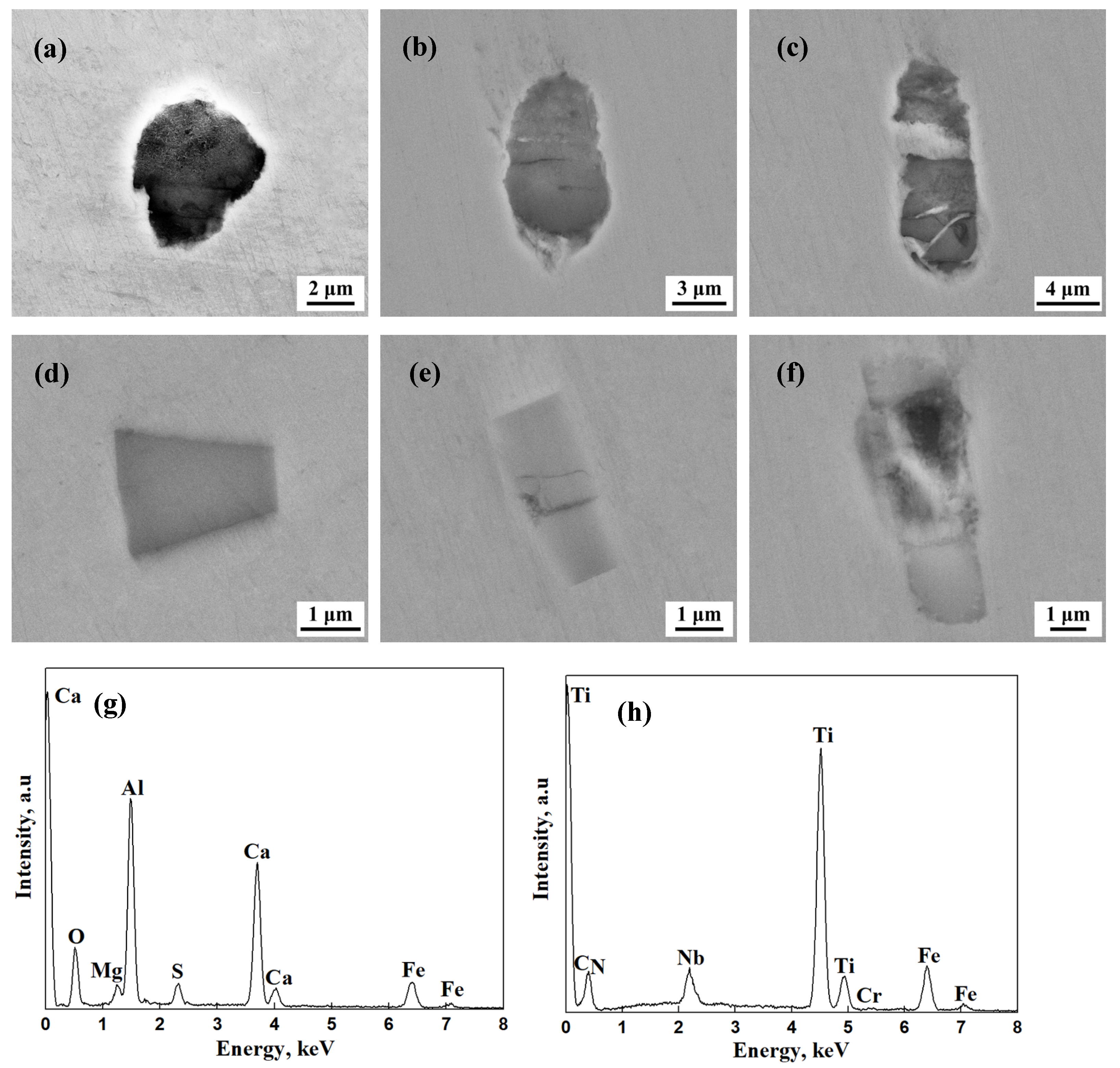
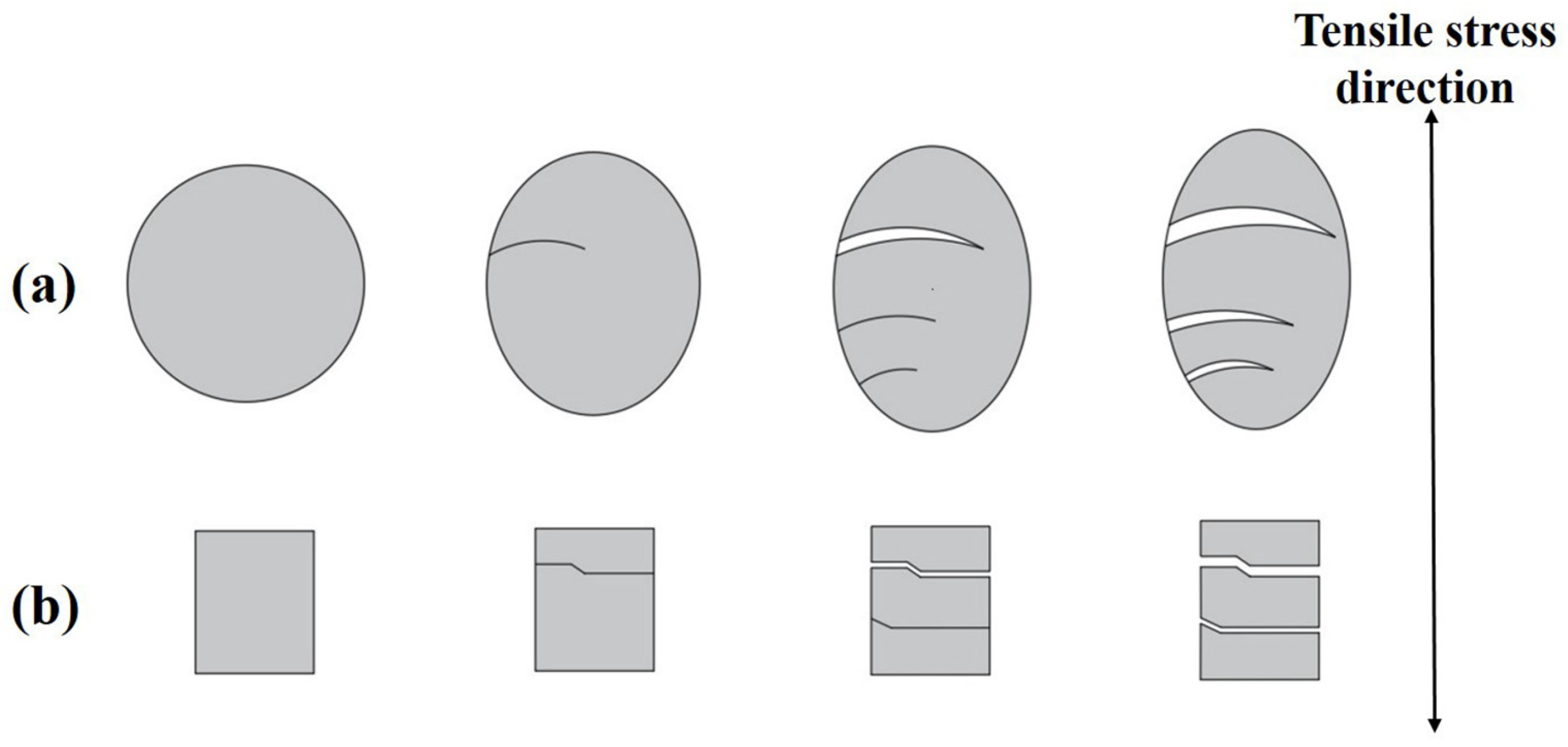
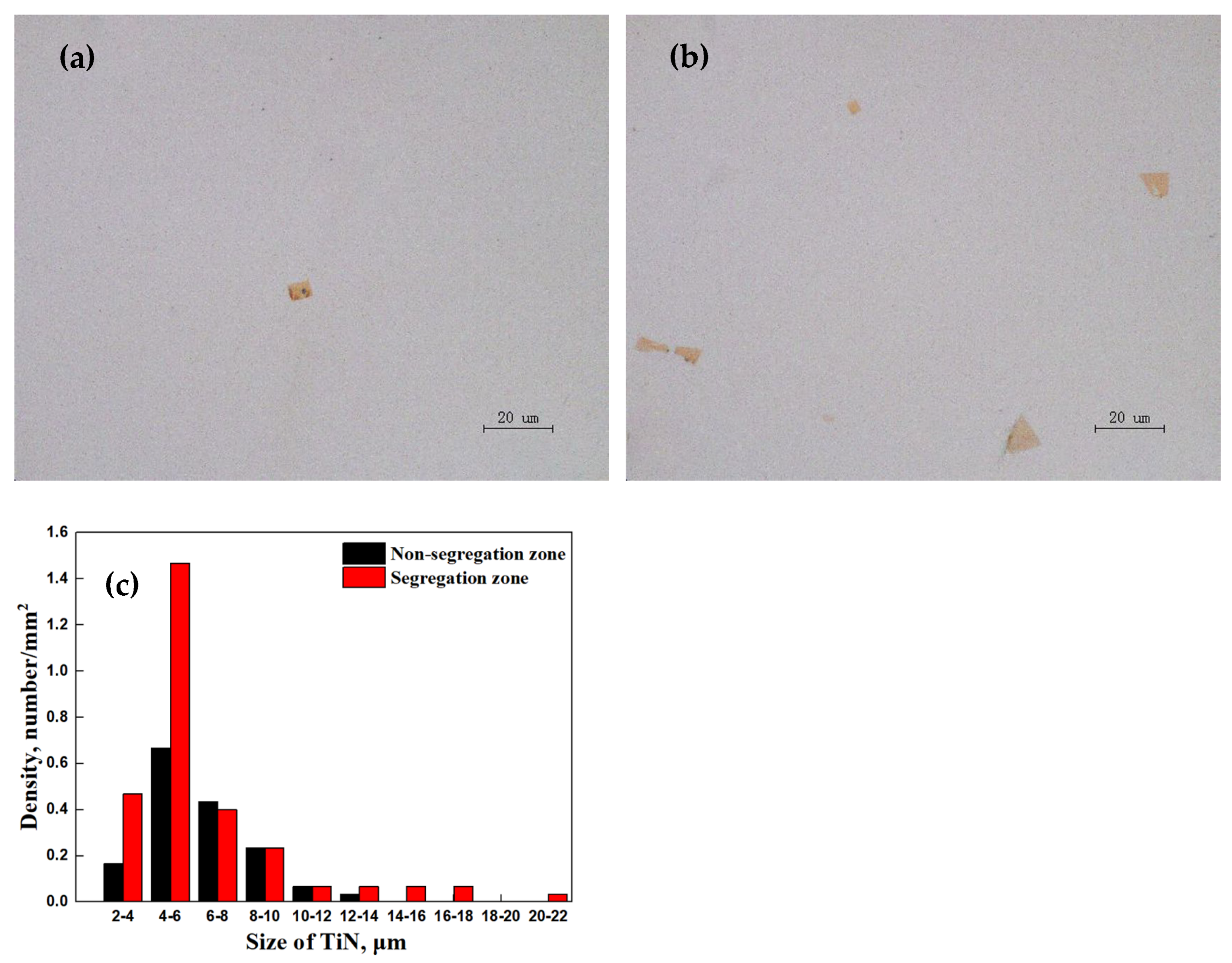
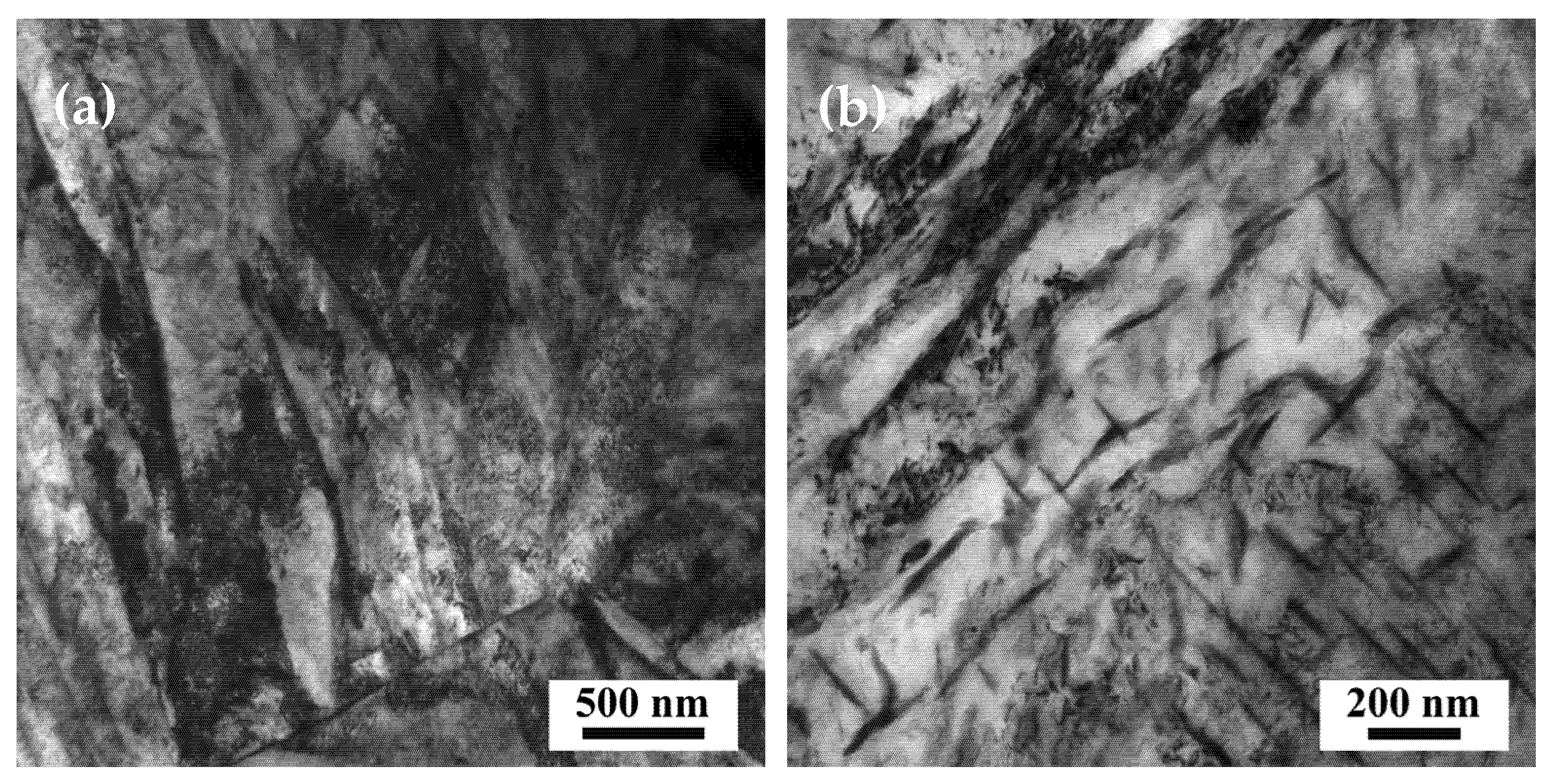
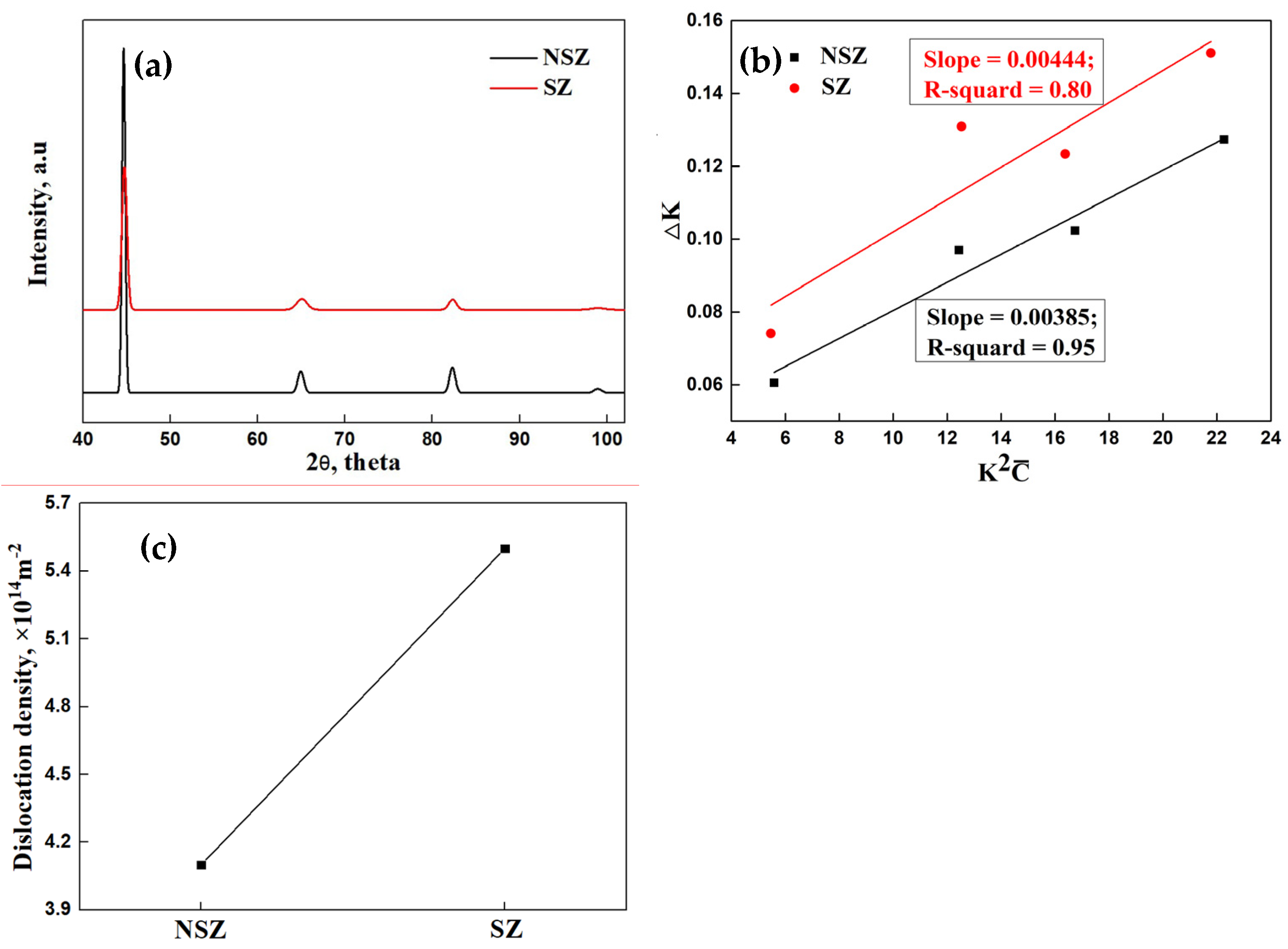
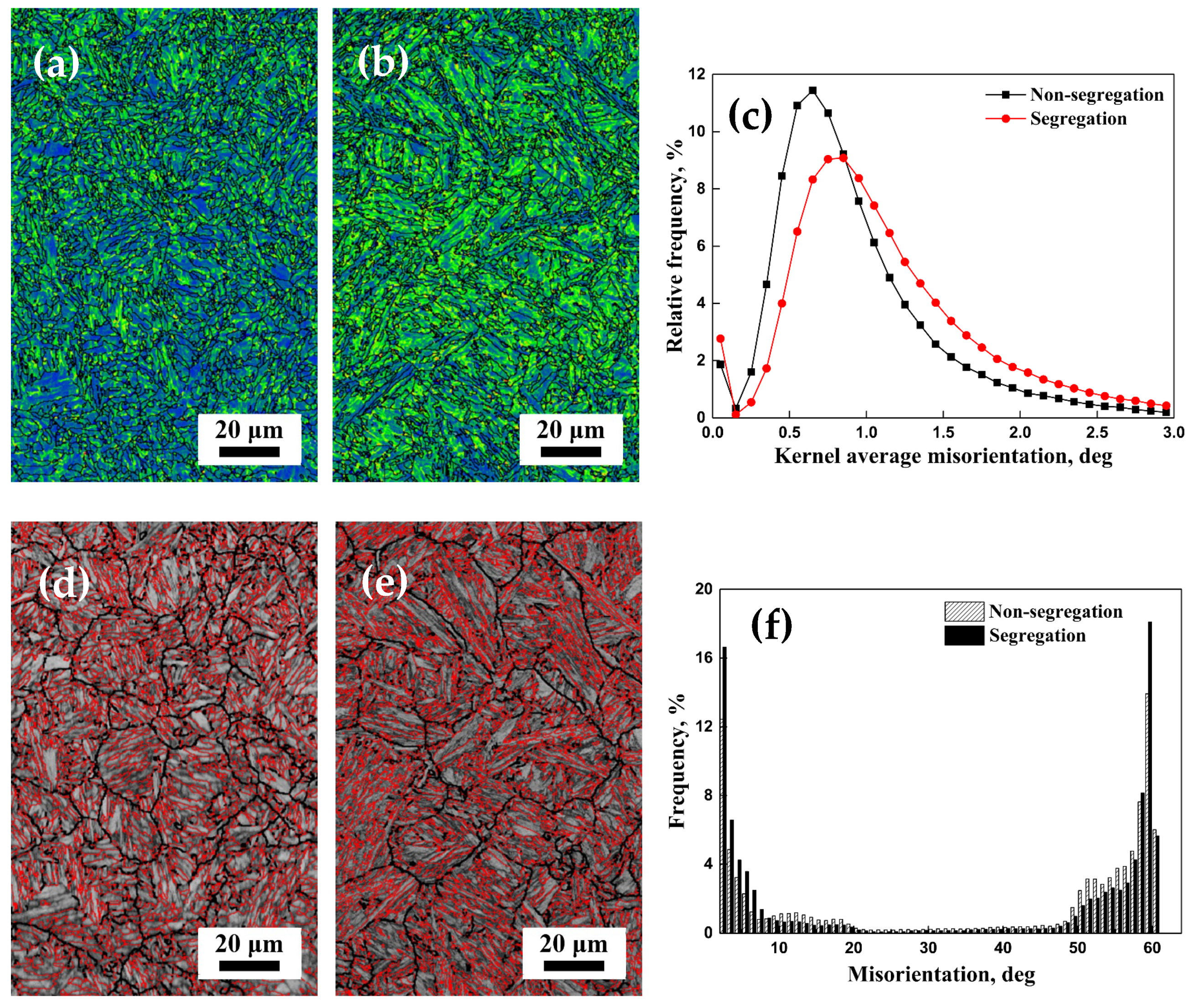
| Direction | Location | Tensile Strength (MPa) | Elongation (%) | Area Reduction (%) |
|---|---|---|---|---|
| Transverse | Segregation Zone | 1606 | 13.5 | 38.4 |
| Non-segregation Zone | 1503 | 16.3 | 54.5 | |
| Longitudinal | Segregation Zone | 1579 | 14.4 | 42.9 |
| Non-segregation Zone | 1474 | 17.7 | 55.6 |
Publisher’s Note: MDPI stays neutral with regard to jurisdictional claims in published maps and institutional affiliations. |
© 2021 by the authors. Licensee MDPI, Basel, Switzerland. This article is an open access article distributed under the terms and conditions of the Creative Commons Attribution (CC BY) license (https://creativecommons.org/licenses/by/4.0/).
Share and Cite
Liu, J.; Liu, D.; Zuo, X.; Liu, L.; Yan, Q. Influence of TiN Inclusions and Segregation on the Delayed Cracking in NM450 Wear-Resistant Steel. Metals 2022, 12, 21. https://doi.org/10.3390/met12010021
Liu J, Liu D, Zuo X, Liu L, Yan Q. Influence of TiN Inclusions and Segregation on the Delayed Cracking in NM450 Wear-Resistant Steel. Metals. 2022; 12(1):21. https://doi.org/10.3390/met12010021
Chicago/Turabian StyleLiu, Jingjing, Denghui Liu, Xiurong Zuo, Lihua Liu, and Qiangjun Yan. 2022. "Influence of TiN Inclusions and Segregation on the Delayed Cracking in NM450 Wear-Resistant Steel" Metals 12, no. 1: 21. https://doi.org/10.3390/met12010021






